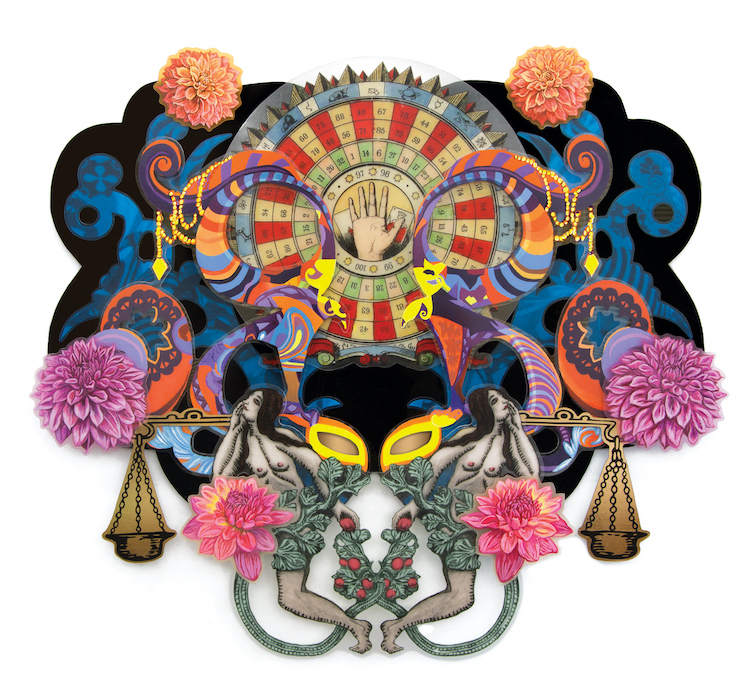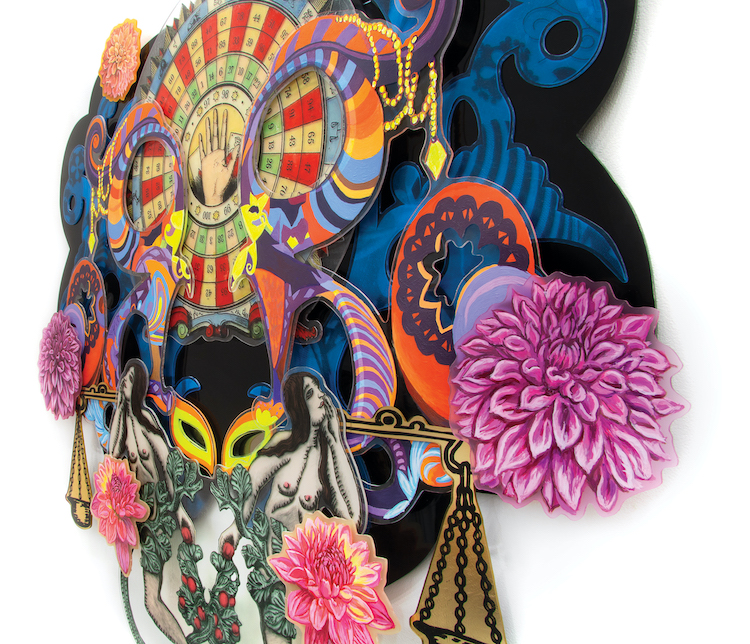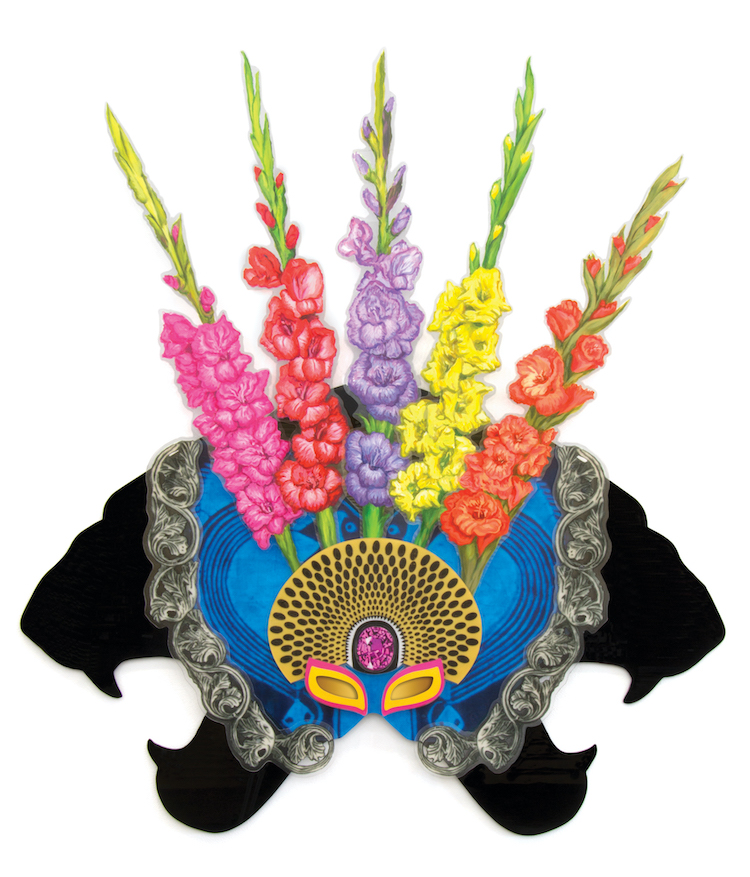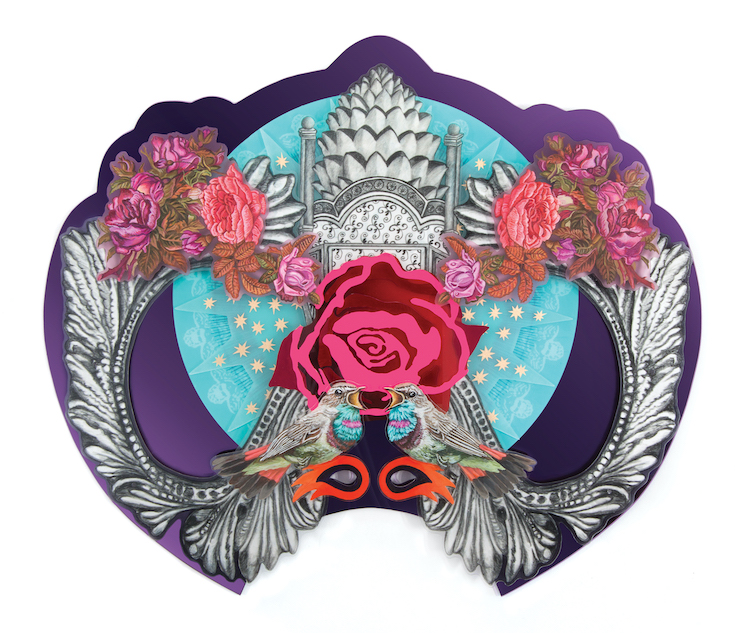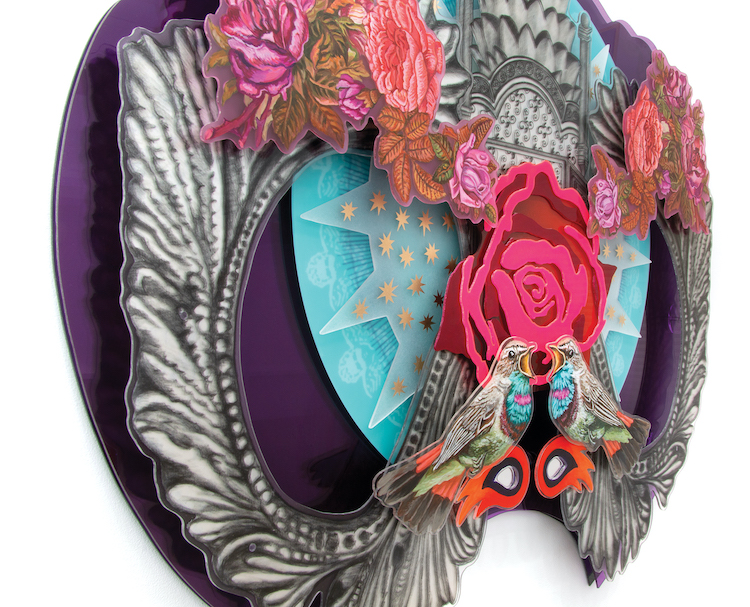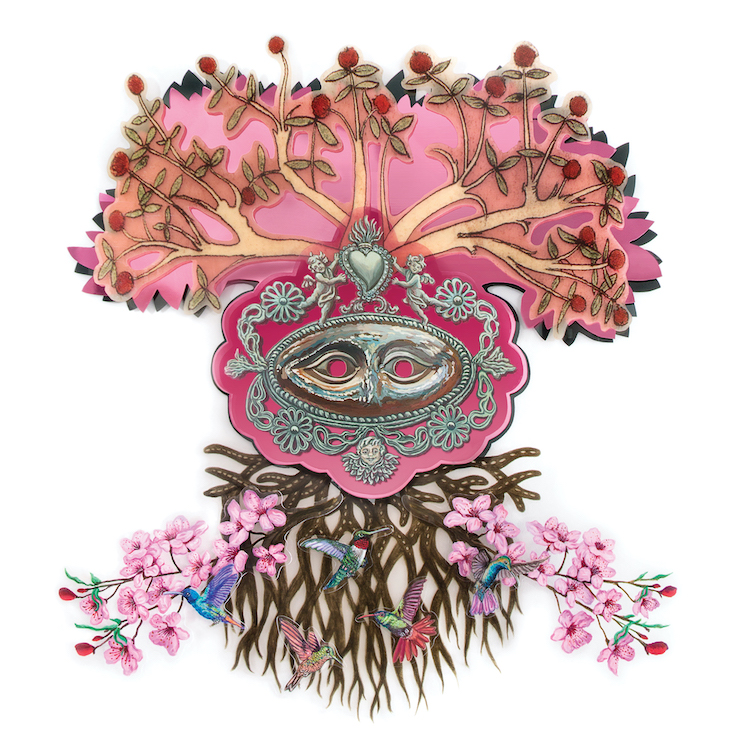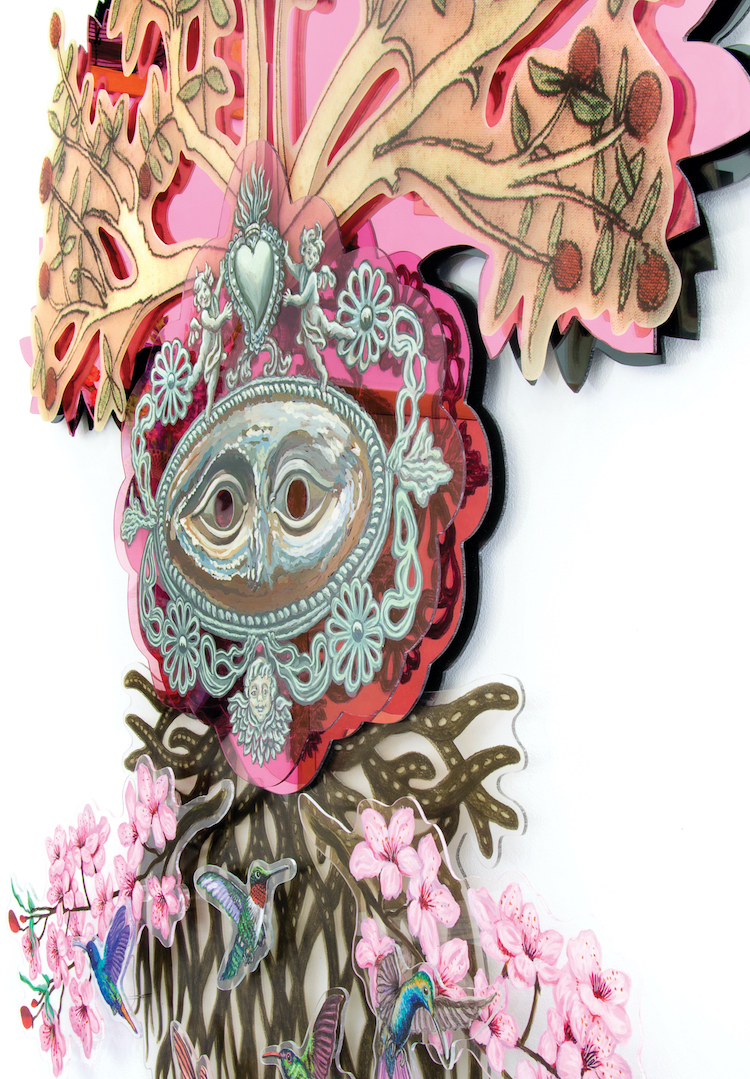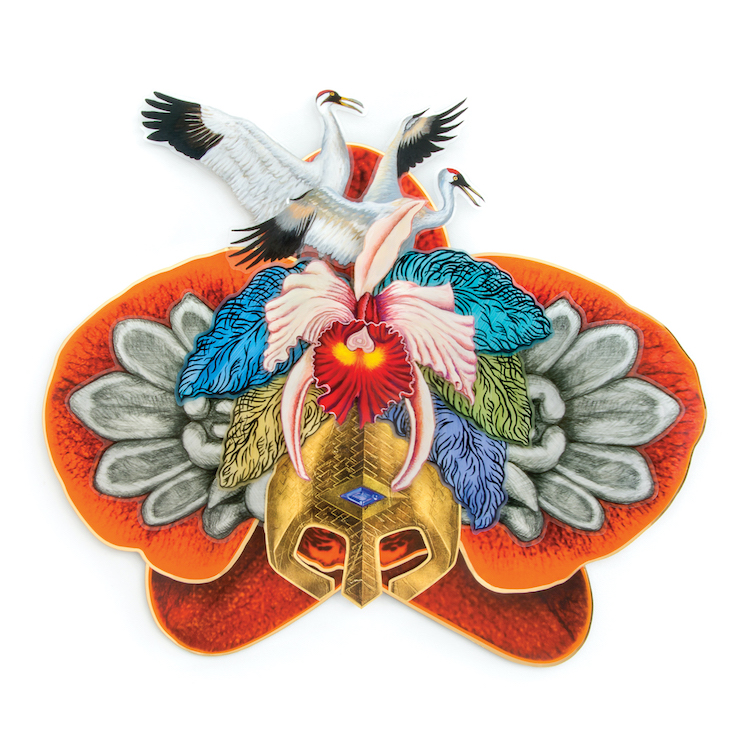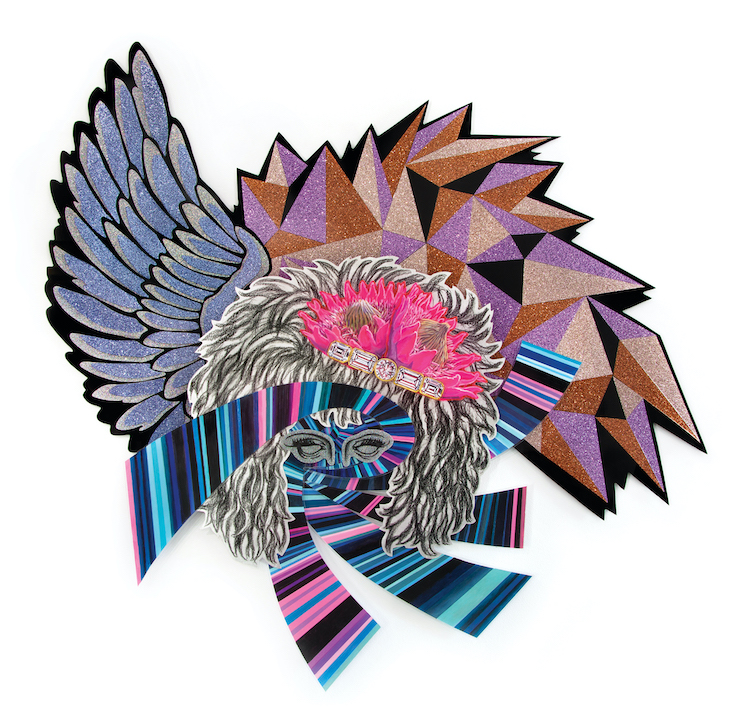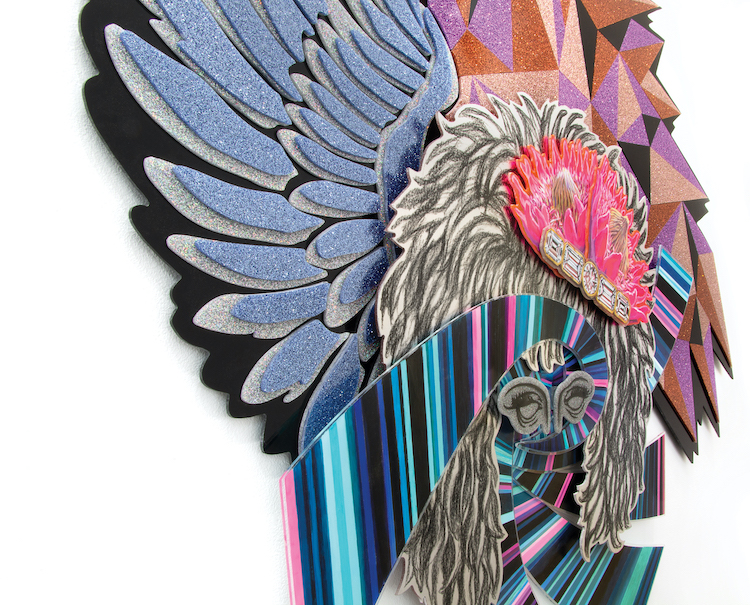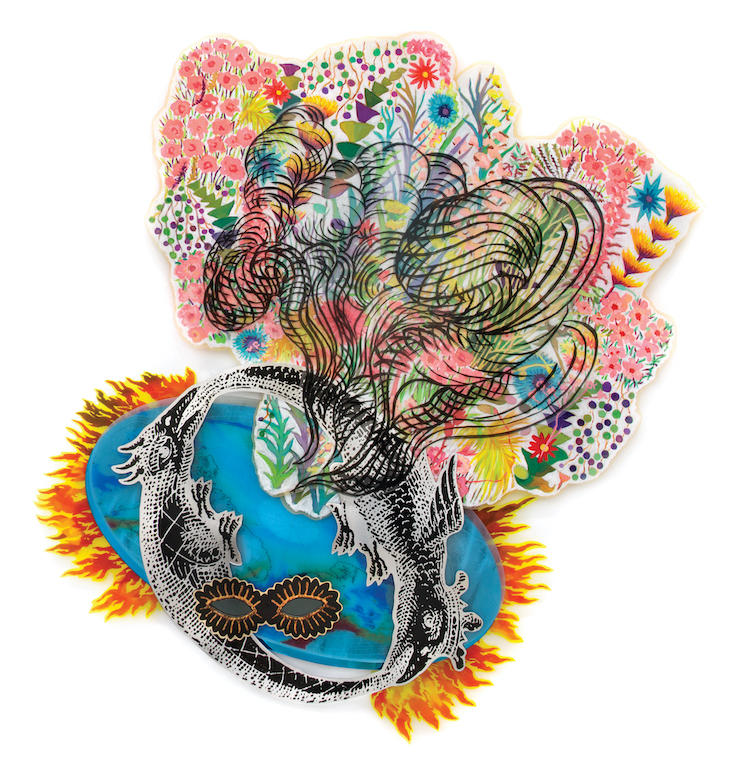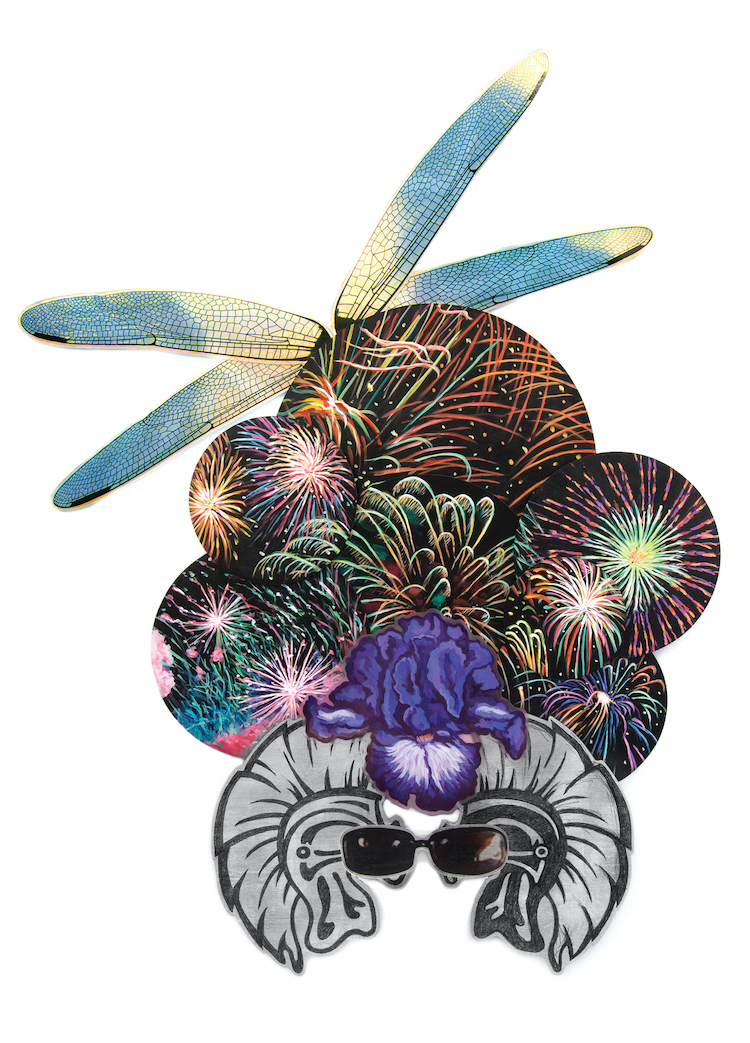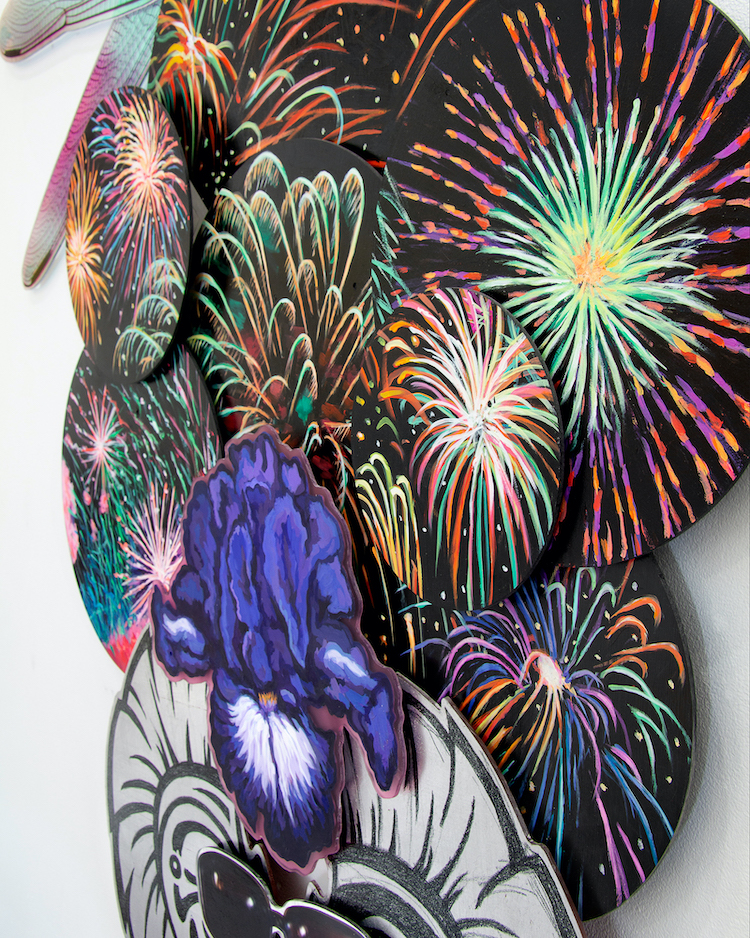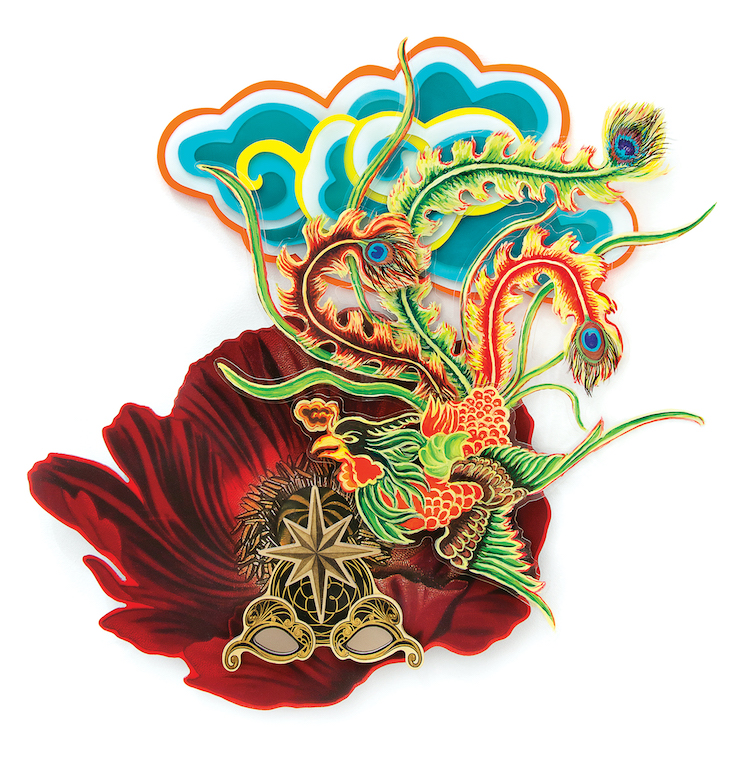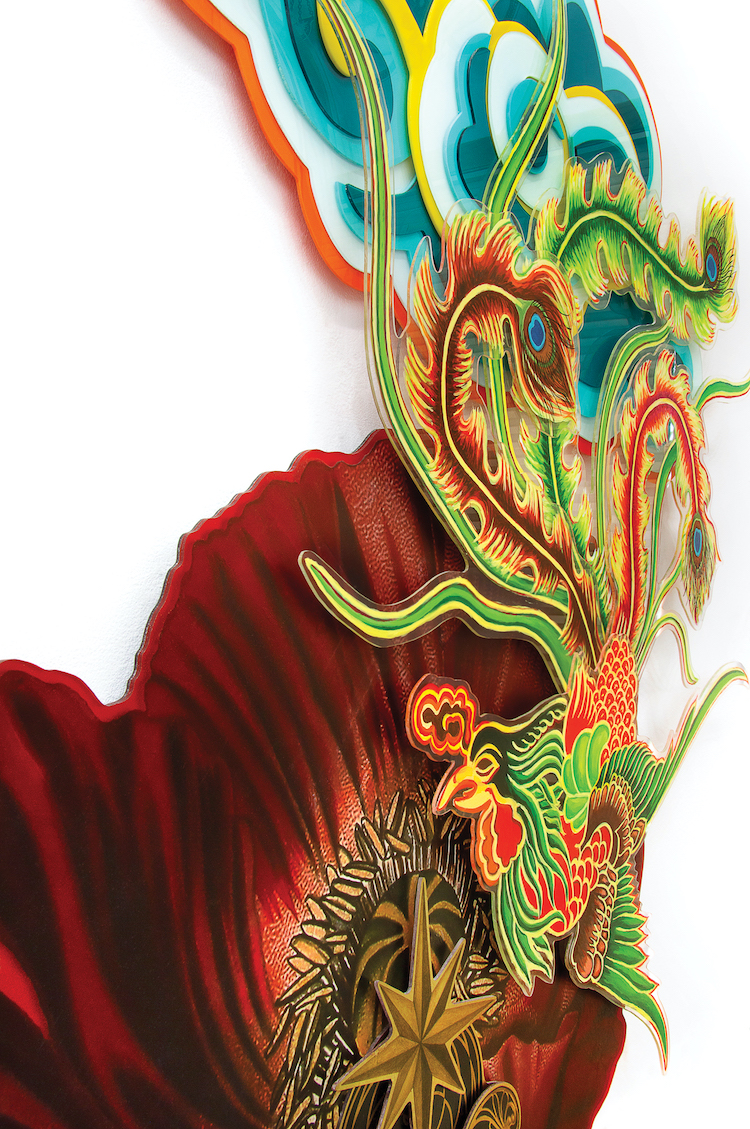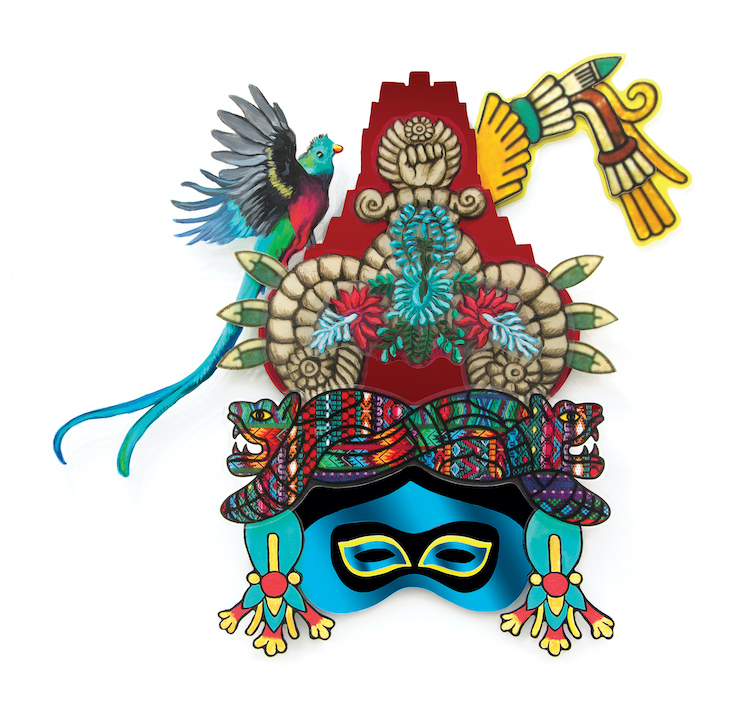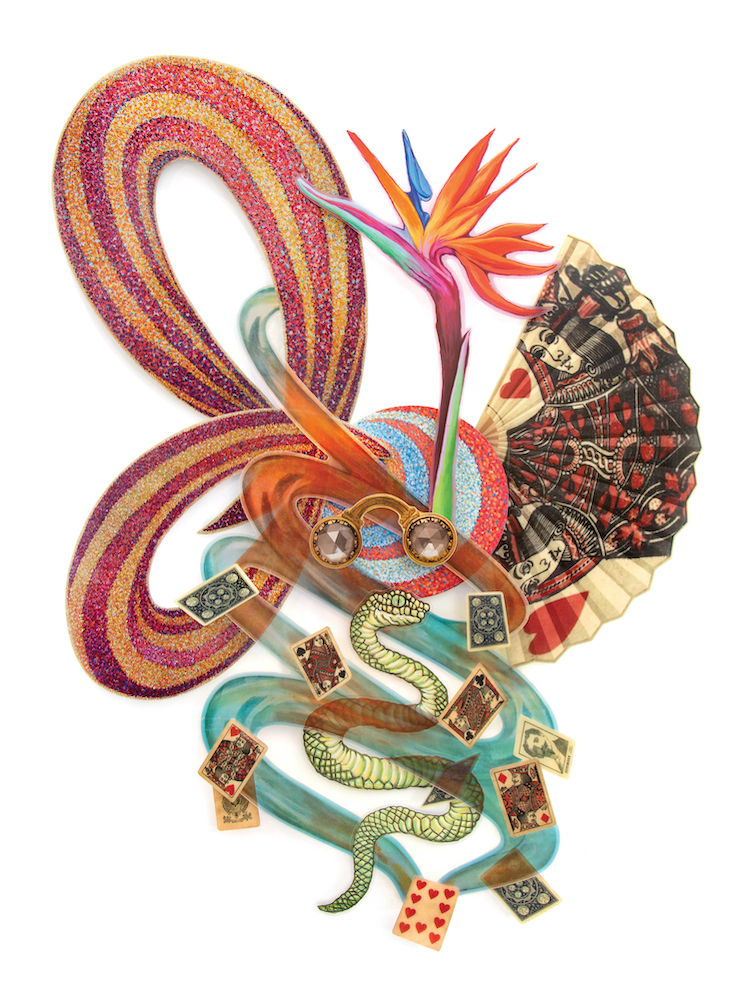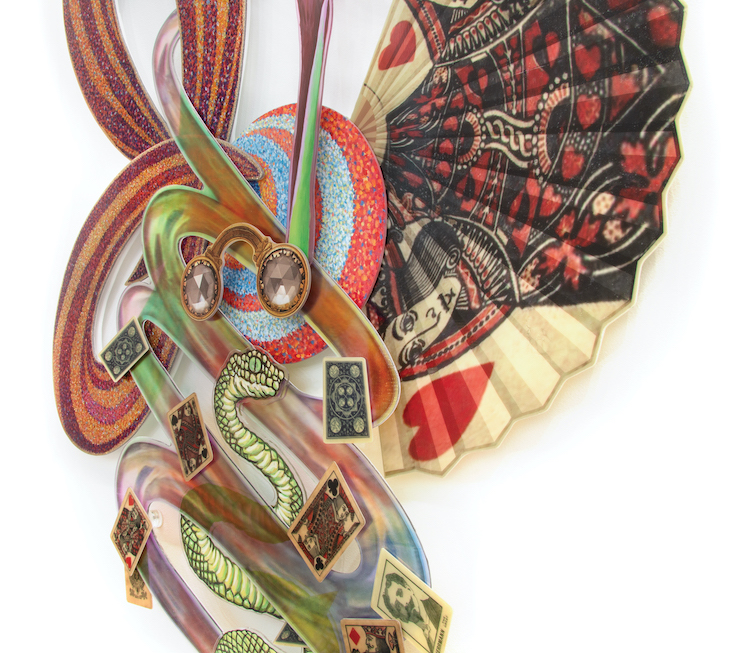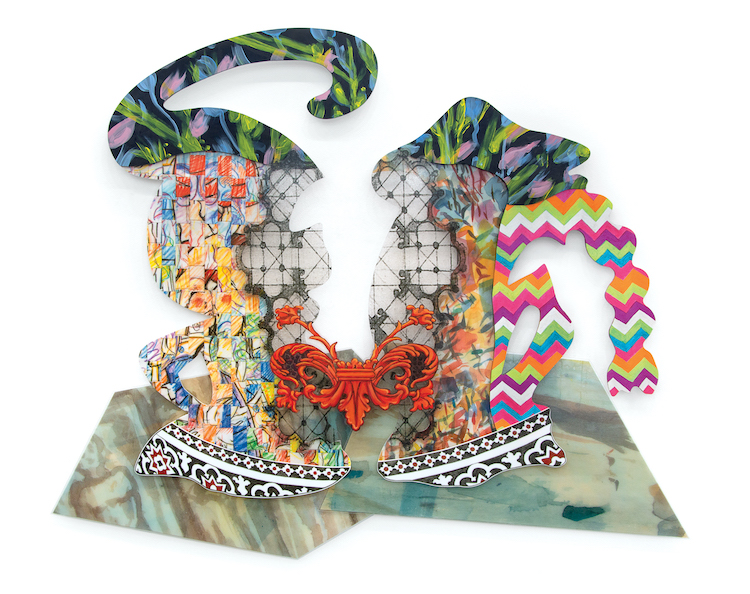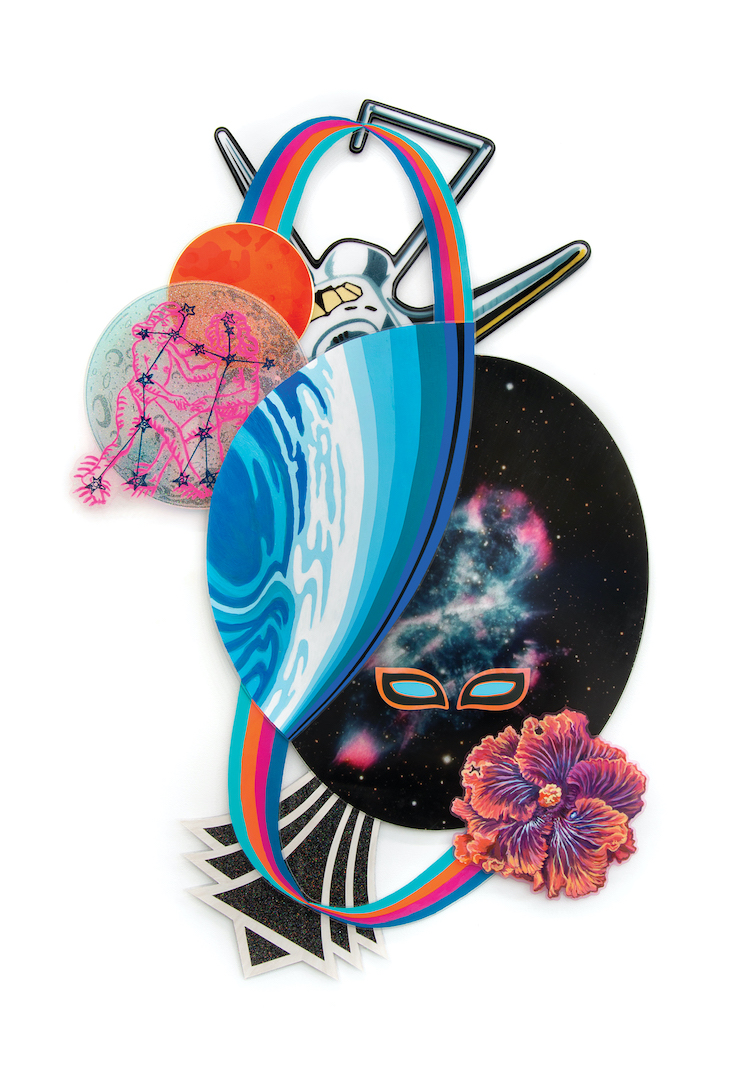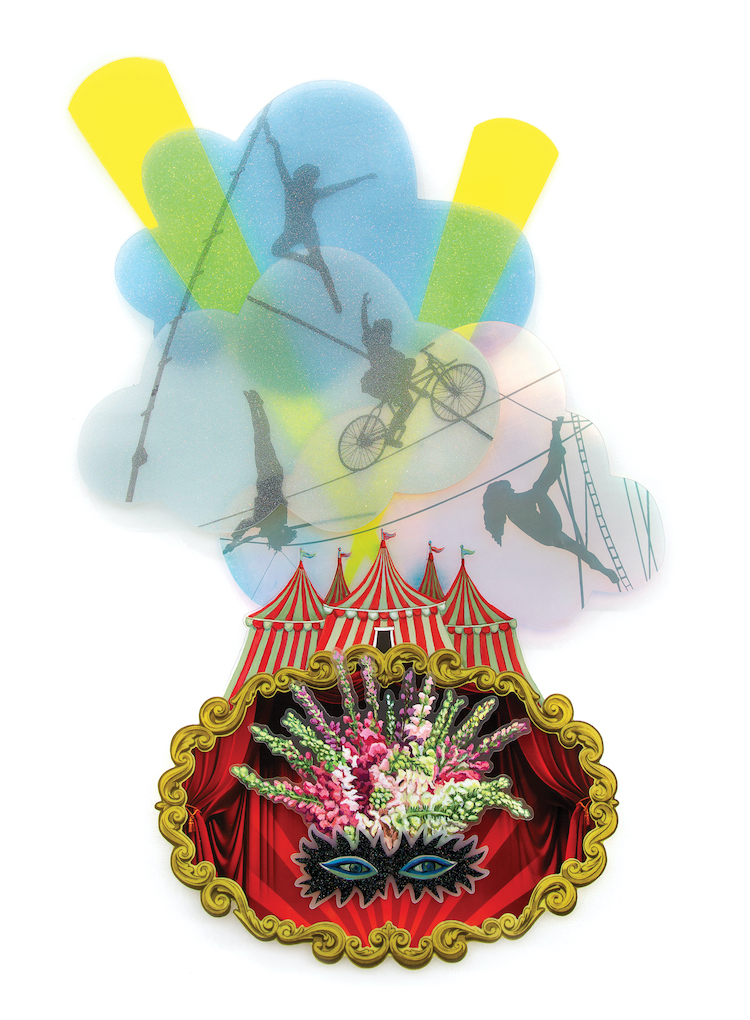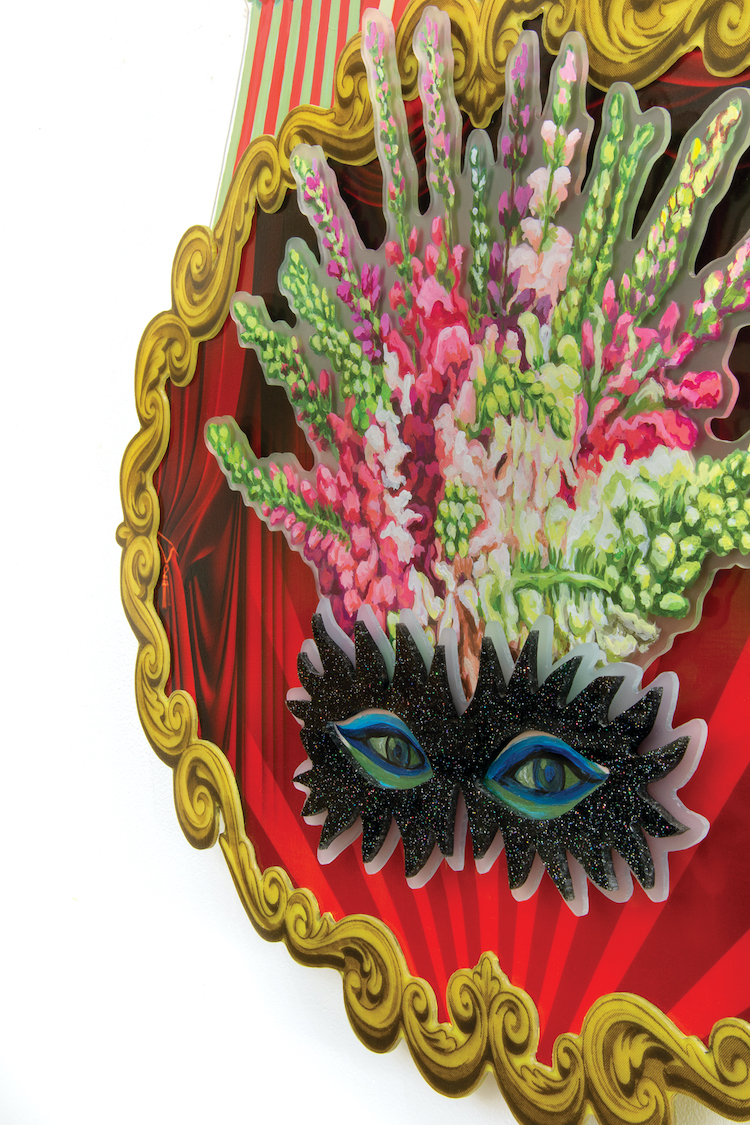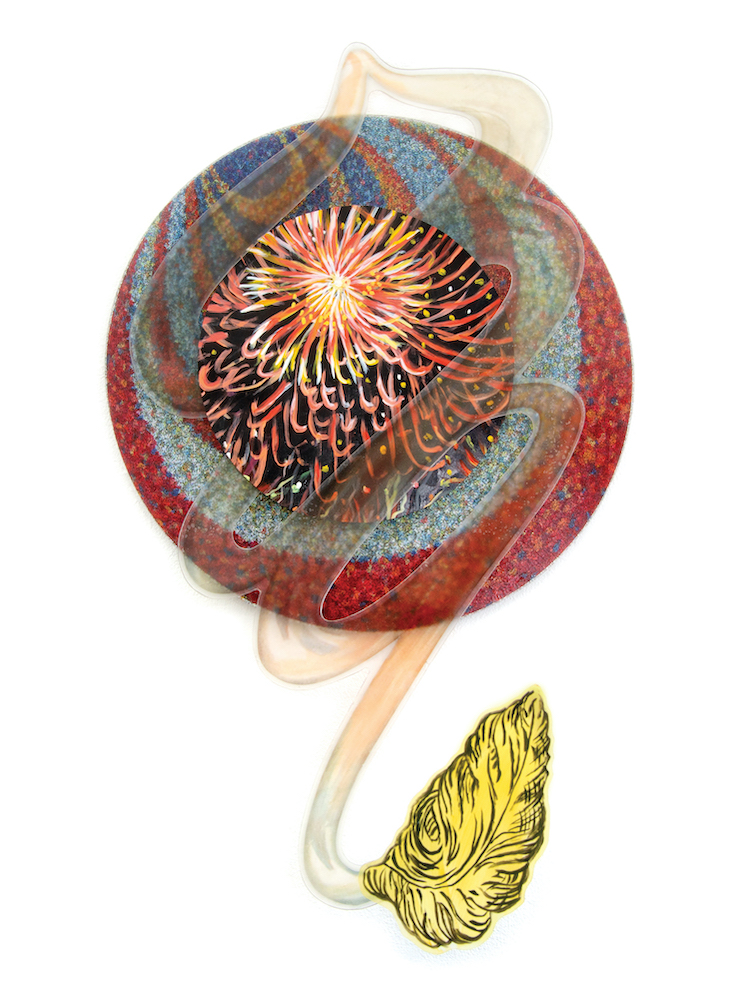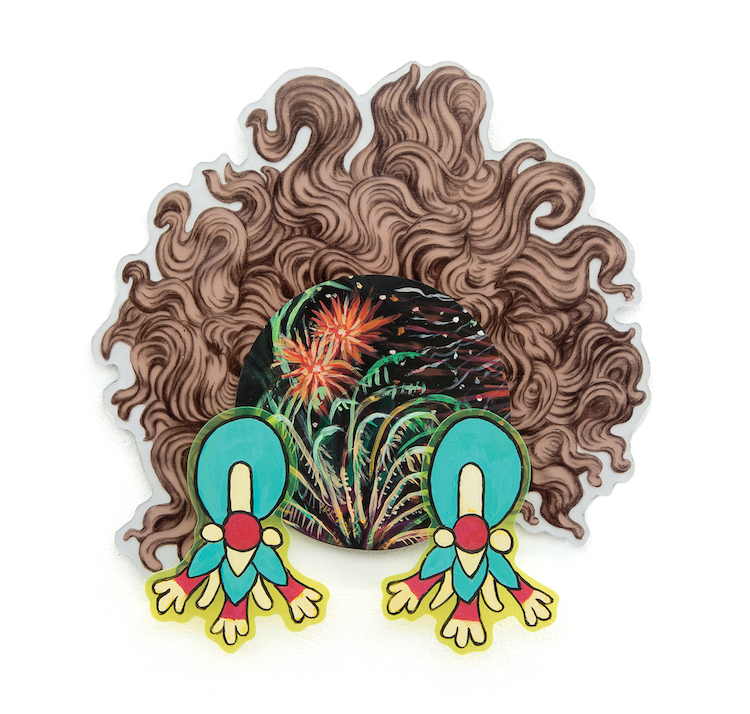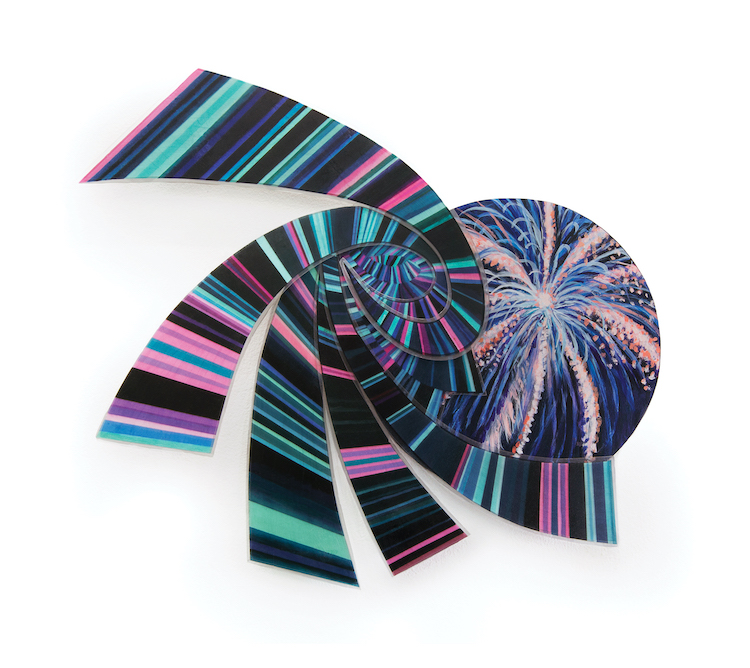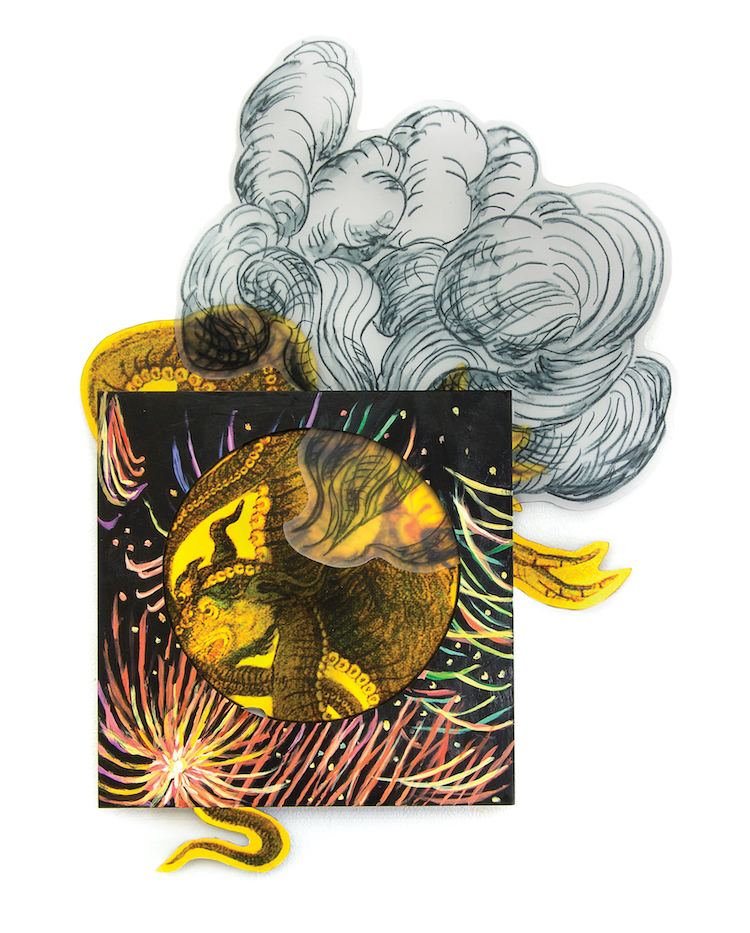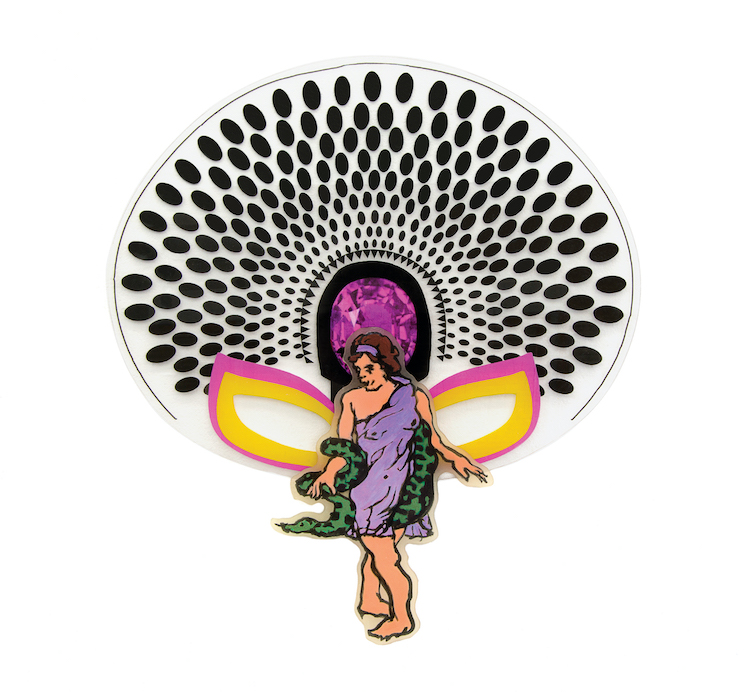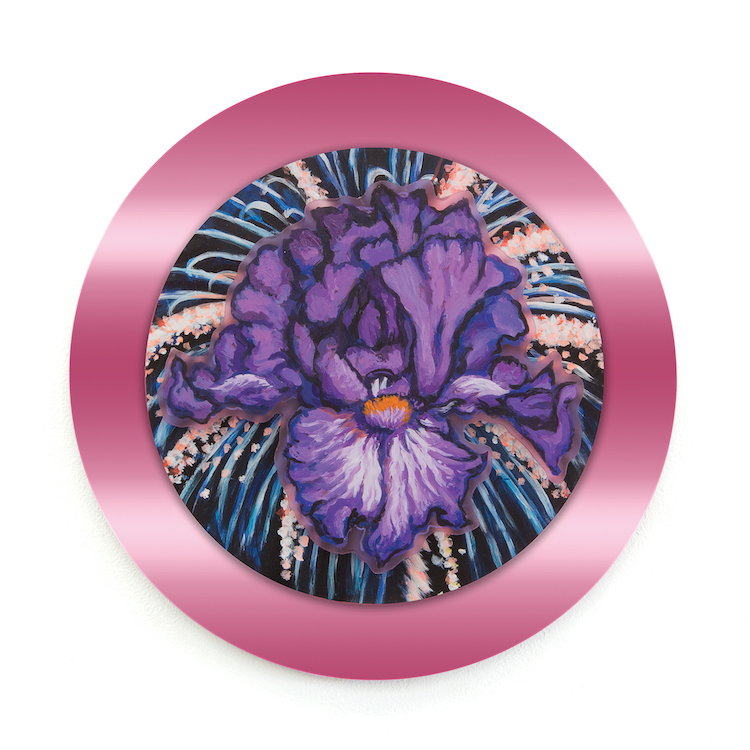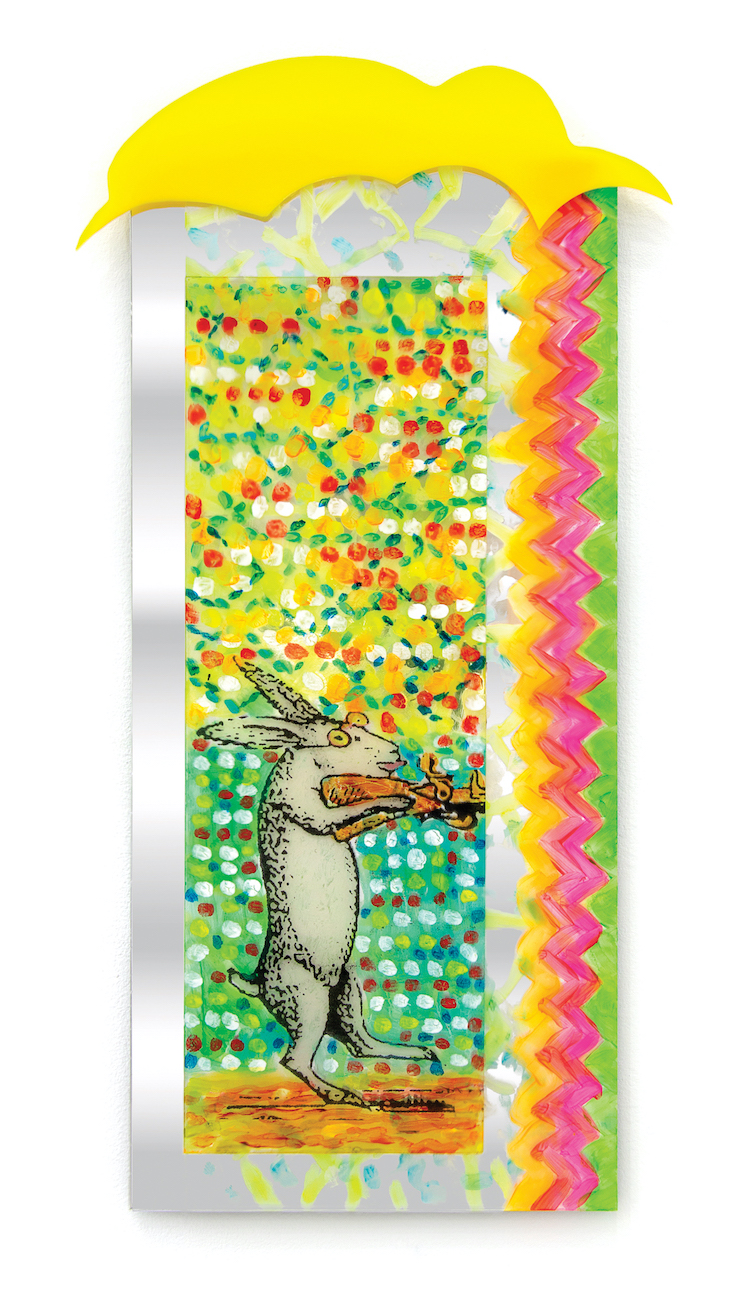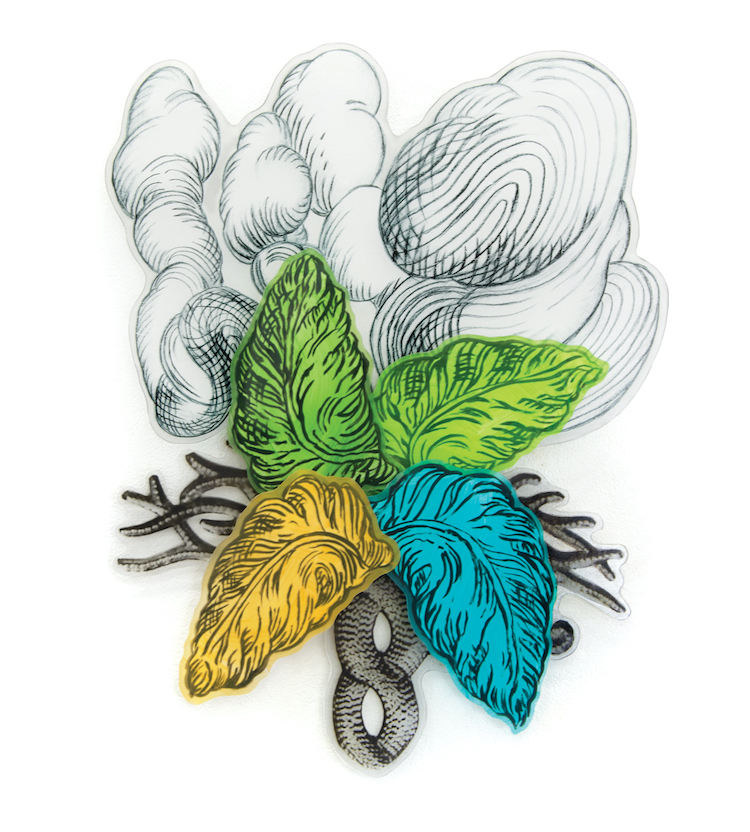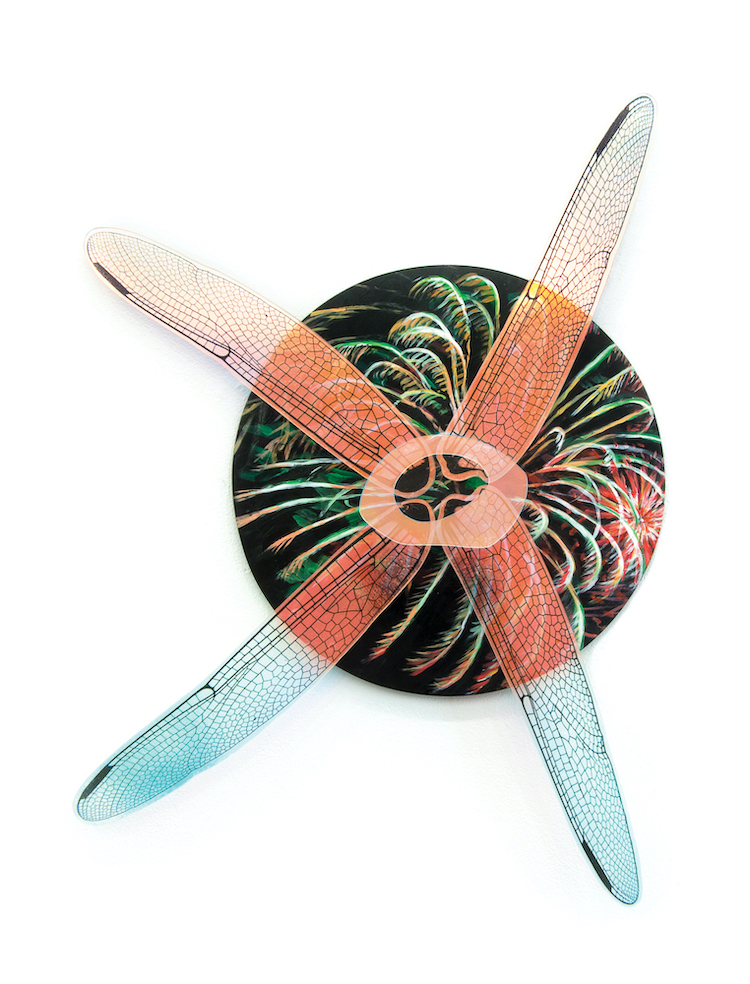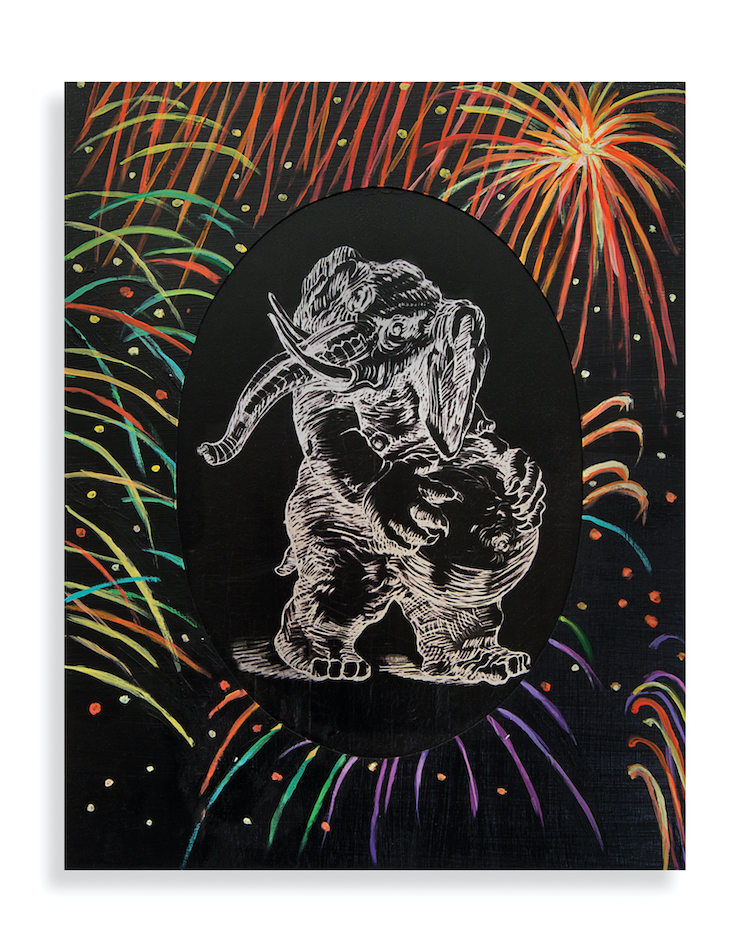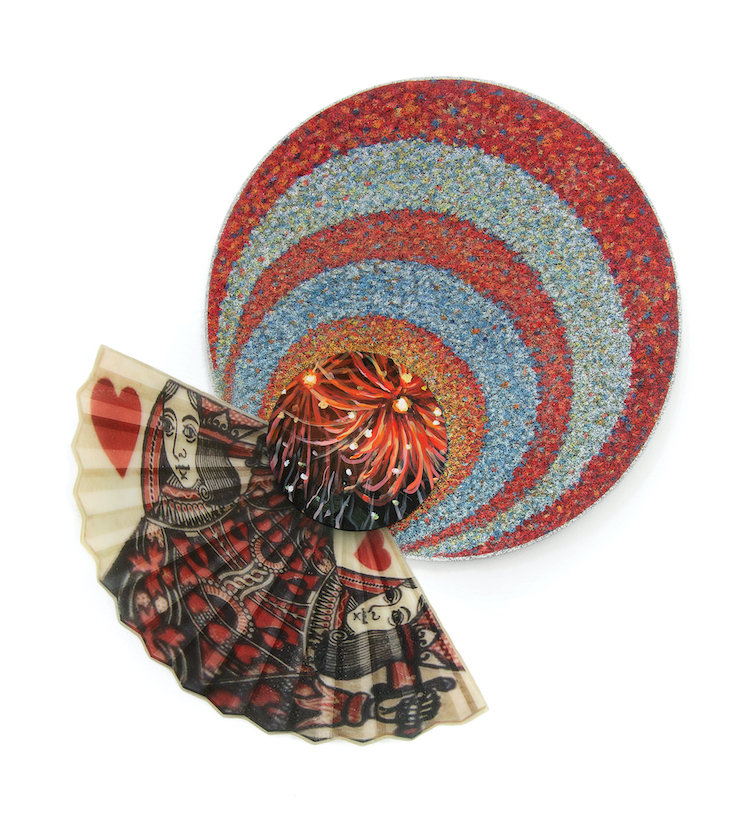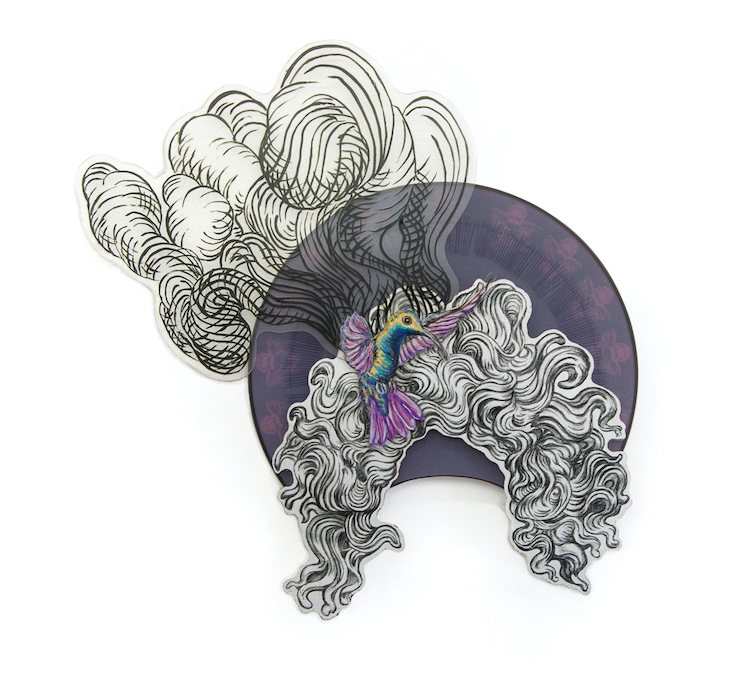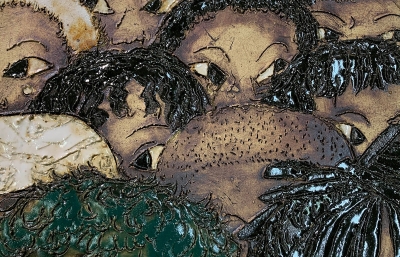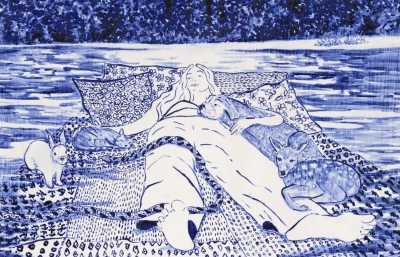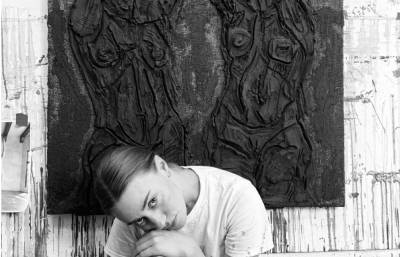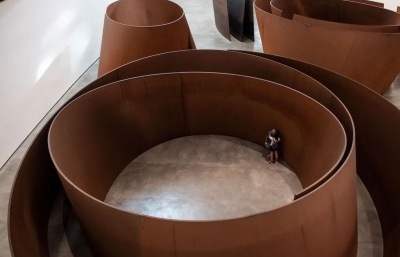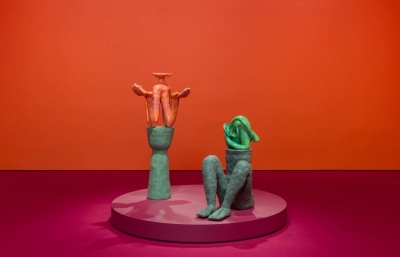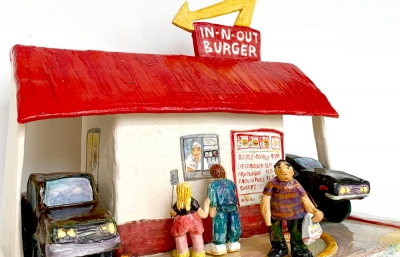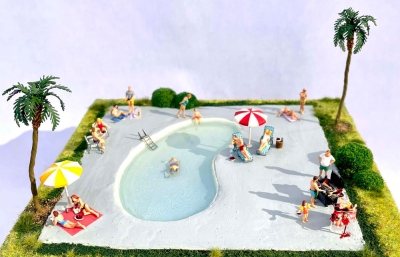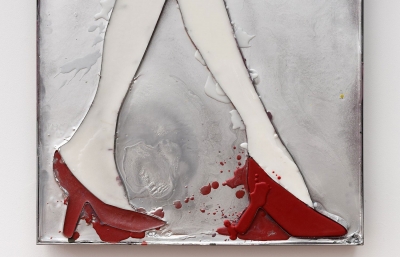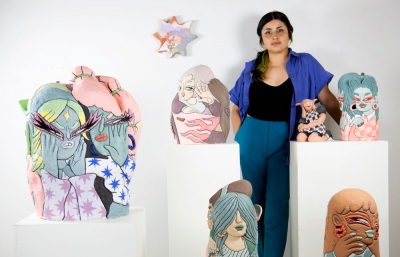A clown’s sad greasepaint and a wicked witch’s gaunt green, shadowed face are intriguing classics. Why so sad, why so angry? Miss America’s tiara framed, lipsticked, blinding white toothy smile is another. Why so happy? Ramping it up are Egyptian death masks, jeweled Venetian masks, and beaked Bwa masks, all reflecting our need to hide, elevate, and communicate identity, fear and desire. Though many express a delight in embellishment, many are seductively enigmatic, often frightening. Pamela Joseph is fascinated by this universal, timeless allure and presents,literally, a multi-layered presentation in Radical Beauty: Mask, Veils & Headgear, opening Friday, September 24 through October 23, 2021 at Michael Warren Contemporary in Denver, Colorado. The multi-layered pieces, conceived in her own drawings, come to life in clear and colored plexiglass, painted and collaged before (almost) coming to life. Pam did not disappoint in our conversation about the show, demonstrating how she finds beauty in every aspect of the creative process.
Gwynned Vitello: Let’s start with the title of your show. It’s interesting to think of how the concept of beauty has changed, personally, because of how one perceives it as they get older. There is the positive aspect of a broader appreciation beyond Western specifications, but there is also a kind of media standard that, unfortunately, is very narrow. How do you perceive the word, and how did you come up with the title?
Pamela Joseph: My personal concept of beauty or being beautiful goes back to my family and has always been an uncomfortable topic. My father would say, “As long as you’re pretty, you don’t have to be smart.” My mother asked me to make something beautiful, which I thought was going to be impossible because my work was always edgy. There has been an unfortunate media standard for beauty, but in my generation I think the emphasis was even more pronounced. It was more important for me to work hard and not focus on physical attributes. I have wondered if I had been born with long legs how it would have changed my life!
Prior to Radical Beauty I had been working on a series that was very political and negative called the Wall of Shame. I had been putting bondage masks called Scold’s Bridles used to silence women and slaves in images of women. When Trump took power, I decided to put those restraining devices on Trump and his thugs. The imagery was so depressing, so I decided to do something that was positive, uplifting and celebratory. In the Spring of 2019 I began this new conceit. I think it was almost by accident that this body of work turned out to be beautiful and that I was able to accept that fact and recognize it as such.
The idea of beauty as a radical thought evolved as the pieces were created. They are radical in a physical way with shape, content and color, but as the pandemic uprooted our lives, I began to think even more about the world around us. Everything seemed so extreme. The universe is chaos with multiple crises of climate change, gender issues, politics and immigration, to mention just a few. In all this turmoil, the idea of something beautiful became radical.

The motifs of masks, disguise and outward appearance call to mind transformation. I’m thinking of Beauty and the Beast, where a disgusting appearance seems to equate an unpleasant angry persona. And when the Beast is transferred into an empathetic creature, he also becomes handsome. How are your masks transformative?
I believe that deep down, the Beast was always empathetic and beautiful. It was only after the spell was broken that his outside appearance matched the surrounding community’s standards. His situation alludes to the duality of ‘radical’ beauty - it’s as much of an internal interpretation as an external one.
I found that wearing masks during Covid has, in a sense, leveled the playing field. Is it more about my deeds and our words? And do you think wearing a mask can free someone from the boundaries of beauty?
I think it would be up to the individual person if they felt a mask released them from their feelings of whether being beautiful made them feel vulnerable. Certainly, wearing a mask is a form of putting on armor and a marvelous way of leveling the playing field. You can look into people’s eyes and see if they are smiling or angry. The words they speak take on extra meaning since you can’t see their mouths while they’re talking. It’s hard to focus on whether they are beautiful or not when their faces are covered. It’s ironic that some people refuse to wear masks in the name of freedom or religion when a mask can liberate you from so many pressures.
Of course, your embellished, colorful masks and headpieces offer the opportunity to expand or break out of a safe, confined space. The fact that Halloween is such a popular holiday, one that adults have fully kidnapped, speaks to our desire to escape from our own skin. How do your pieces speak to that?
What could be more fun than losing your identity and releasing a powerful alternative personality? I have always been fascinated with the idea of Carnival, the Sideshow and the similar situation of Halloween. Men can dress as women or clowns; women can wear outrageous costumes and feel free of impunity. It is a time of celebration and a release valve for the emotions and stresses of our world. There is a sense of humor and playfulness that is missing so often in our daily lives, most especially as we grow older.
What are some favorite motifs in the show, and are many of them new iterations of symbols you have explored in the past?
Some, in the sculptures, are of birds, domestic and religious patterns, eyes, architectural elements and nature. The most salient features, however, are the flowers. I decided with the first piece that each of them would have a flower within. The flowers were selected as representative of the person or theme that I was developing. I began to realize that the floral elements, so fragile and the epitome of beauty, are actually the strong and resilient warriors. All flowers have a meaning, such as faith, valor, integrity, dignity and wisdom—and I decided to name each piece after a corresponding flower.
I have not used most of these motifs in the past, or at least, not in this kind of format, so it’s quite new and refreshing. Many years ago I painted enlarged renderings of a single petal, but I have never been a landscape artist of a foer painter. In RAdical Beauty I loved painting them! The flowers are all so intricate, especially the snapdragons whose petal formation is so delightful.

I saw the Judy Chicago retrospective at the de Young museum twice last week. Although it did not feature The Dinner Party, I notice that you pay homage to many women with your masks. When did you get that idea, and tell how you executed the references to people like Malala Yousafzai and Michelle Obama?
I’m so jealous that you saw the Judy Chicago retrospective at the de Young—no less than two times last week! I’m a huge fan of her work and persona and went to see the Dinner Party when it first opened. It was staggering! My work has always focused on feminist issues and the power of women When I began to think of the mask/headdresses it was natural for me to research indomitable female personalities. Originally, a specific woman inspired each sculpture, but it also wasn an opportunity for me to explore certain topics related to that person. For example, with Malala it was education and for Michelle, it was politics, elegance and intelligence.
As in my interactive exhibition the Sideshow of the Absurd, the masks are a conceit that gives me the opportunity to explore issues that interest me, such as politics, climate change, space, art, music and human rights. Some of the motifs in Malala are the cherry blossoms for learning, hummingbirds that signify joy and healing and the painted antique flk mask with the cherubs, for youth and wisdom.
I also noted that, like Judy Chicago, your sculptural pieces have an architecturally exciting three dimensionality. Her apprenticeship at an auto-body shop really informs the carhoods which are powerful for their shape, as well as their color. Tell us how you made the journey from drawing to multi-media pieces?
It’s very intuitive to relate my work to Judy Chicago. I do think there are a number of similarities. I was also an apprentice in an auto body shop where I learned to spraypaint. I airbrushed lacquers and candy color paints with metal flake and pearlescent powders onto aluminum for almost 20 years. I was a New York artist enamored of the California Finish Fetish artists. The only women in paint shops at that time appeared naked—on wall calendars.
I always drew when I was young and then began to pai, but I’ve always loved exploring a variety of materials. I used plexiglass as a support for painting abc in the 70s. The Sideshow of the Absurd allowed me to investigate a wide number of mediums, including sound and animation in creating the exhibits. The Lady Sword Swallower is carved out of wood and The Strong Woman Cat—aka Pussy Marshmallow - is paper mache on a welded steel frame. The Aliene fortune teller incorporates projection, animation and performance, as well as painting and sculpture. I use the computer a lot in designing my pieces going back and forth between drawing and the computer. I’m also trying to learn to draw on my iPad, which is a new challenge.
It’s impossible to resist one more Judy Chicago reference in that you both credit collaboration with other artists. Tell us about the benefits of living with another artist, in your csae, Robert Brinker. And For those of us unfamiliar with the Anderson Ranch Arts Center, explain how that community broadens your practice?
You can’t mention Judy enough. I am so that she is now getting the respect that her work deserves. I have always enjoyed collaborating with other artists and architects. When I was doing the spray-painting work, I did a number of public art commissions because of the durability of my materials. I worked with the architects Helmuth, Obata and Kassabaum on a GSA commission for the San Jose Federal Courthouse elevator lobby. I find that you learn a tremendous amount by working and collaborating with others.
Living with another artist and sharing a studio is such a positive situation for both of us. Robert is a terrific artist, and I think some of my best ideas come from our conversations. Our work, at first glance, might look different but we share many similar concerns about process, color and collage. We have collaborated with our friend Kurosh ValaNejad in a group called WKRPinc. We designed wallpaper, fabrics and paintings based on interwoven body parts that look deceptively like gardens of Victorian tendrils. In 2004, WKRPinc did an installation at the Aspen Art Museum that extended into the walls of the bathrooms. Rob and I also collaborated in 2019 on a show called Hybrids at Francis M. Naumann Fine Arts in New York City.
I wouldn’t be living in Aspen if it weren’t for the Anderson Ranch Arts Center. Aspen is a beautiful place but the cultural element is very important for me. I took my first class at the ranch in 1990 and used it as my graduate school. I had been doing the spray painting work, it was literally toxic and I wanted to change direction. I was able to take classes in ceramics, woodworking,paintings, printmaking and creative studies with an incredible faculty. The Ranch brings an amazing array of artists and strives for diversity and the support of art making. I continued to take classes. A seminar with the Guerilla Girls was a thrill for me, having been a fan for many years.I also took a Crit class with the powerful trio of Helen Molesworth, Cathay Opie, and Christine Quarles. Finally, I took an iPad drawing class with the very special Simon Haas. The lecture series is world renowned, and this summer, among others, Derrick Adams and Simone Leigh spoke. Anderson Ranch is a tremendous resource for so many artists at all stages in their careers.

As someone who incorporates painting printmaking and sculpture into her work, how will this project inspire your next body of work? Or are you going into another, totally different direction?
Moving the work out of the studio and into a gallery is a transitional moment. It’s a time to step back and look at the work objectively. During these periods, I often feel uncomfortable not knowing what ‘m going to do next, but I’m trying to stay at ease with my discomfort. I think I will probably continue along similar lines. I like painting on a smooth surface, and the plexiglass is fun to shape and paint on. It allows me so much flexibility and freedom. I always wanted to use my drawings in larger scale pieces, and now, computer and transfer methods make that possible. I don’t know if the work will specifically be about women, but my narrative and concerns have remained constant over the years. While making the sculptures and maquettes, I had leftover parts that did not fit into the compositions. The remnants inspired a series of small sculptures called A Network of Offshoots that will also be in the show. They were more spontaneous and allowed me to balance the structure of my studio practice. I would like to keep that element of chance in the work as I proceed.
Radical Beauty: Mask, Veils & Headgear: Pamela Joseph @ Michael Warren Contemporary is on view through October 23, 2021

